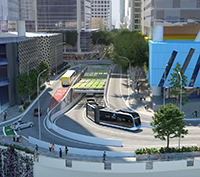
About Brisbane Metro

The first stage of Brisbane Metro is underway and will provide two new Brisbane Metro lines connecting 18 stations along dedicated busways between Eight Mile Plains and Roma Street, and Royal Brisbane and Women’s Hospital and The University of Queensland. All of Brisbane will benefit from a greater transport network, with easy links between Brisbane Metro, bus and train services.
Benefits
- Reduce congestion bottlenecks in the city for a better-planned network
- Making it easier to travel with turn-up-and-go services and 24 hours on the weekend — no timetables needed
- All-electric vehicles with zero tailpipe emissions for a cleaner and greener Brisbane
- Creating 2600 jobs throughout design and construction
Background
Brisbane Metro will be a key part of Brisbane’s greater transport network connecting the city to the suburbs. New high-capacity and high-frequency Brisbane Metro services will run along dedicated busways and link with suburban bus and train services as part of a better-planned network.
Brisbane Metro was announced in early 2016 to address congestion bottlenecks in the city and constraints on the bus network, along with meeting the demand for frequent and reliable travel to the city.
In May 2017, Council released the Brisbane Metro Business Case. This followed a 12 month detailed assessment of the benefits, costs and impacts of delivering the project.
In March 2018, the project was confirmed as a high priority project on the Infrastructure Australia Priority List.
The Draft Design Report released in April 2018, describes the construction and operation of Brisbane Metro in detail. The report was available for consultation:
- on Council’s Your Say community engagement website
- at community information sessions
- at briefings with key stakeholders.
In September 2018, Council released the Brisbane Metro draft Design Report Consultation Outcomes document. This document provides a summary of key feedback themes identified through consultation and Council's response.
Council announced world-leading vehicle manufacturer HESS and Hitachi ABB Power Grids as the preferred supplier to design and build the fully electric Brisbane Metro vehicle fleet in late 2019.
HESS and Hitachi ABB Power Grids will deliver a zero-tailpipe emission vehicle that provides a more sustainable and energy efficient solution for Brisbane.
In October 2020, the Brisbane Move consortium, comprising of ACCIONA and Arup, was awarded the contract for the Collaborative Partnership. Brisbane Move will partner with Council to design and deliver the major infrastructure works for the project.
The expected cost to deliver Brisbane Metro is $1.4 billion. Brisbane Metro is funded in partnership between Brisbane City Council and The Australian Government.
Key elements
The first stage of Brisbane Metro is underway and will include:
Infrastructure
- a new tunnel beneath Adelaide Street and revitalised streetscape from North Quay to Edward Street
- an upgraded Cultural Centre station
- an enhanced gateway to the Cultural Forecourt with new landscaping and wider footpaths
- significant public realm improvements at Melbourne Street and Grey Street
- changes to Victoria Bridge to provide three lanes for Brisbane Metro and bus services, and dedicated cycling and pedestrian pathways
- upgrades to some suburban stations including end of route vehicle charging facilities.
Brisbane Metro vehicle
- a new fleet of 60 battery electric Brisbane Metro vehicles, following successful testing of the pilot vehicle
- zero tailpipe emissions, saving an estimated 50,000 tonnes of greenhouse emissions over 20 years
- all day electric operation with flash charging in under six minutes at end of route
- bi-articulate design, providing three spacious passenger compartments
- three large double doors along the length of the vehicle for quicker boarding
- low-floor design from front to rear, providing a high level of accessibility
- three large mobility aid bays in the first passenger compartment with automated on-request ramp access at the first passenger door
- capacity for 150 passengers in comfort and 170 in event mode
- in-built USB charging points and on-board Wi-Fi, to help commuters stay connected
- passenger information displays and next stop audio and visual route information
- separated driver's cabin
- panoramic rear window, for taking advantage of city views
- interior illuminated ceiling
Policies and operations
- all door alighting and boarding
- cashless fares
- reduced vehicle dwell times
Network and services
- two new Brisbane Metro lines
- a 21-kilometre service connecting 18 stations and providing interchanges at 11 locations
- complement Cross River Rail with interchanges at Boggo Road station and Roma Street station
- a revised network to future proof our city.
Timeline
Key milestones in the development of Brisbane Metro.
| 2016 | Brisbane Metro concept announced |
|---|---|
| 2017 | Business Case released |
| March 2018 | Brisbane Metro added to the Infrastructure Australia Priority List |
| April 2018 | Draft Design Report released |
| May 2018 | $300 million Australian Government commitment |
| June 2018 | Project construction fully funded |
| July 2018 | Procurement commenced |
| September 2018 | Draft Design Report consultation outcomes released |
| November 2019 | Brisbane Metro vehicle design and build tenderer approved |
| Late 2019 | Early works commenced |
| October 2020 | Collaborative Partnership contract award |
| January 2021 | Project Overview Document released |
| February 2021 |
|
| Mid-2021 | Brisbane Metro depot early works commence |
| Late 2021 |
|
| 2022 |
|
| Early 2024 | Metro depot construction completion |
| Late 2024 |
|
*subject to approvals.
Contact information
If you have any questions or would like more information about Brisbane Metro, you can:
- register for project updates
- phone the project team on 1800 692 333 during business hours
- phone Council on 07 3403 8888 after hours
- email the project team
- write to:
Brisbane Metro
Brisbane City Council
GPO Box 1434
Brisbane Qld 4001.